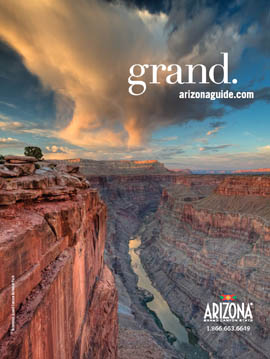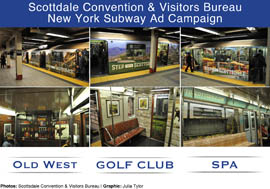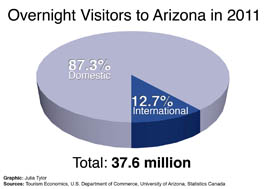Cronkite News has moved to a new home at cronkitenews.azpbs.org. Use this site to search archives from 2011 to May 2015. You can search the new site for current stories.
With economy improving, groups out to sell Arizona as tourist destination
PHOENIX – When former Scottsdale resident Mark Macias used the New York City subway’s 42nd Street Shuttle this past winter, he was transported not only between Grand Central Station and Times Square but back to his hometown.
Floor-to-ceiling images transformed the shuttle car into an Old West saloon compete with rows of liquor bottles and swinging doors. On the outside of the car, “Step into Scottsdale” was superimposed over images of the craggy and cactus-covered mountains of the McDowell Sonoran Preserve.
“What’s different about the shuttle (advertising) is that … it basically takes up the entire train. So you walk inside, and essentially you feel like you are in the desert,” said Macias, who owns New York City public relations firm Macias PR.
Scottsdale isn’t the only Arizona city showing up in more out-of-state advertising. Mesa’s and Tucson’s campaigns are getting makeovers, and the Arizona Office of Tourism is marketing the state internationally for the first time in years.
The advertising push comes with the economy improving and people more likely to spend money on travel.
“The industry has come back from the Great Recession, and generally things are looking good,” said Cheryl Cothran, director of the Arizona Hospitality Research & Resource Center at Northern Arizona University.
Economic indicators show the upswing is breathing life back into the tourism industry. In Arizona, revenue per available room, considered a good measure of the health of the industry, was up 8.7 percent in February over the same month a year earlier.
For the Scottsdale Convention and Visitors Bureau, the improving economy meant a reason to step beyond traditional advertising and deck out a total of three New York subway cars with inside-and-outside advertising, with each car displaying a different theme.
“It’s kind of like an escape,” said Macias, the PR professional. “Even though it’s only a two-minute ride, it’s an escape when you’re on that train.”
An escape was precisely what the Scottsdale CVB had hoped to provide. The campaign, which ran from February through mid-March and reached an estimated 65 million people, was part of a larger effort to target potential visitors in cold climes such as Chicago, Denver and Canada.
“We’ve done TV commercials, we’ve done radio spots, we’ve done billboards before, but we kind of took it to a new level this year, teasing a little bit more and finding new ways to get that message across,” said Rachel Pearson, vice president of community and government affairs for the Scottsdale CVB.
While Scottsdale was the only Arizona city touted via subway wraps, those promoting other cities have ramped up their advertising efforts in different ways.
Visit Mesa, which promotes Mesa as a tourist destination, is in the midst of designing an extensive marketing makeover that is expected to launch in June.
Michelle Streeter, a spokeswoman for Visit Mesa, said the timing of the campaign stems in part from the looming completion of developments such as the Metro light-rail extension and the new Chicago Cubs spring training stadium.
Projects such as these took a hit during the recession, Streeter said, but now that the economy is improving and they are nearing completion, Visit Mesa felt the time was right to elevate awareness of what Mesa has to offer.
“You’re going to see us be more aggressive as we launch the rebrand,” she said.
In Tucson, hotel occupancy was up 10 percent in February compared with the same month last year and was the highest in the state, according to the Arizona Office of Tourism. The Metropolitan Tucson Convention and Visitors Bureau, like Visit Mesa, has been working to revamp Tucson’s image as a tourist destination.
For the state Office of Tourism, the improving economy, coupled with a $7 million general fund appropriation approved by Gov. Jan Brewer and the Legislature for 2013, has allowed for a more extensive advertising campaign than in recent years.
Corporate groups in particular are back for the first time in three years, Office of Tourism Director Sherry Henry said. She added they are coming to the state in larger numbers and spending more than they used to.
“That was one of the things that took the big hit, was the corporate and the association market,” Henry said. “It just basically almost stopped traveling during that three-year period. And those that did, they didn’t spend the money that they had in years past. So, I think … it is definitely better than it has been since ’08.”
The general fund appropriation played a large part in Arizona tourism’s revival, as well, Henry said. After five years of a shrinking tourism budget, she said, the funding was necessary for the state to market itself more aggressively.
The money allowed Arizona to increase its presence in both national and international markets.
The national campaign, which ran from November through March and cost $4 million, was the first since fiscal 2010. The office also spent $1.2 million on advertisements in cold-weather cities, targeting potential visitors longing for sunshine.
The Office of Tourism’s international campaign is its most extensive international effort yet, Henry said. It has been live in Canada since the fall and will begin in Mexico this summer, targeting Arizona’s two largest international markets.
Brewer has proposed another $7 million appropriation for the Office of Tourism in fiscal 2014. Henry said that money, coupled with the improving economy, would allow the office to pursue the same opportunities next year as it did this year.
In addition to its current target markets, the Office of Tourism is looking to expand its international efforts to Brazil and China, Henry said. The office’s marketing efforts go beyond advertising to include media, trade and community relations.
“The more funding that we have, the more aggressive we can be,” Henry said. “That’s ultimately what it’s about.”









